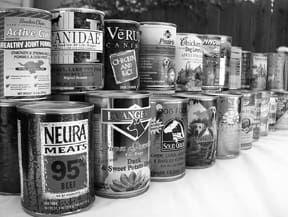Selling the entire concept of canned food to diehard kibble fans is an uphill battle. It’s expensive, dog owners frequently complain. It smells bad. It’s not very convenient. It has to be kept in the refrigerator once it’s opened. When you have big dogs, you have to open too many cans to make a meal!
These may be valid points. But have you ever noticed how dogs are crazy for the stuff?
It’s possible that dogs like canned food simply because it smells strong. But it may also have something to do with the fact that canned dog foods usually contain much more meat sometimes twice as much or even more than dry dog foods.
Canned foods also retain their nutritional value better than dry foods. Further, the nutrients contained in the food ingredients suffer less damage in the cooking process than the nutrients in the ingredients of kibble. (Note that vitamin/mineral mixes are added to all commercial foods, to ensure the finished products contain minimum levels of a range of nutrients needed by dogs the canine equivalent of the recommended daily amount.)
The amount of protein and fat in a food before and after it is canned are virtually unchanged. Neither does the canning process affect most vitamins. It has been said that vegetables can lose more vitamins by lying in a refrigerator for a week than in the canning process.
Canned foods usually contain far fewer chemical additives than dry foods, if any at all. It would be wasteful to use artificial flavors in canned products; because of the moist, fragrant nature of the meat-based contents, artificial flavoring and other palatants are not needed to entice dogs.
To destroy any possible bacterial contaminants, cans are subjected to heat processing after they have been sealed. This obviates the need for preservatives to keep the food from spoiling. (This does not mean the foods are entirely free of preservatives; some ingredients have preservatives added to them before they arrive at the pet food plant. As long as the maker does not add preservatives, this hidden ingredient does not have to be declared on the food label.)
Thanks to the oxygen-free environment, canned food is prevented from degrading for at least several years. Note that because they lack added preservatives, canned food must be kept refrigerated after opening, and, like fresh meat or poultry, is best consumed within a day or two.
It’s the water
The most obvious difference between canned and dry dog foods is the moisture (water) content. Most canned foods contain about 78 percent moisture; one we know of contains 88 percent moisture.
Canned dog foods contain so much water for two reasons. The most important one is because water helps facilitate the production process; without added water, the mixed ingredients would be too thick to flow through the mixing and filling machines in the manufacturing process. (This is why water is often described on the list of ingredients of many canned foods as water sufficient for processing.)
By the way, eating a food that is so high in moisture is helpful for dogs with cystitis or kidney disease. The high moisture content can also help a dog who is on a diet feel full faster.
Moisture-laden ingredients such as fresh vegetables and, especially, fresh or frozen meats are most efficiently used in canned foods. In the production of dry food, moisture has to be removed from these ingredients, which uses energy and costs money. Because water-filled ingredients can be used so efficiently in wet foods, they are. This is another reason canned foods, even lower quality examples, tend to contain more fresh or frozen meat and fresh vegetables than their dry counterparts.
When a mix of good quality, fresh or frozen animal products are used in a canned food, the resulting food will often contain the amounts of protein (and range of constituent amino acids) and fat required by law; all that is needed to make it complete and balanced is a vitamin/mineral supplement, and sometimes some ingredients to correct the calcium-phosphorus ratio. Whereas with dry foods, the manufacturing equipment can’t tolerate mixtures that contain more than 50 percent meat, canned foods may contain as much as 95 percent meat.
Further, meat and by this we mean all animal proteins, including poultry, pork, fish, lamb, and beef is the most palatable ingredient that pet food makers have at their disposal. Funny how dogs like what’s good for them.
WDJ’s selection criteria
Like every type of dog food, only a small percentage of canned products are of the utmost quality. The bulk of the market pursues high-volume sales of low-cost foods. Only a few manufacturers have trained their sights on the top end of the market, where dog owners expect only the best ingredients and utmost performance from the food healthy, happy companion dogs; show dogs with great coats, teeth, and eyes; breeding dogs with perfect production records.
There is no legal definition of a premium or super-premium food, so what it means when manufacturers describe their products with those words is anybody’s guess. Some justify the appellation with the explanation that their products are extremely high in protein or fat. However, a high protein and fat content does not make a food better. You can definitely feed a dog too much of either one.
Here’s how we determine whether a canned food is truly premium. The following is our selection criteria for a top-quality product:
We eliminate all foods containing artificial colors, flavors, or added preservatives.
We reject foods containing fat or protein not identified by species. Animal fat and meat proteins are euphemisms for low-quality, low-priced mixed ingredients of uncertain origin.
We reject any food containing meat by-products or poultry by-products. There is a wide variation in the quality of the by-products that are available to dog food producers. And there is no way for the average dog owner (or us, for that matter) to find out, beyond a shadow of a doubt, whether the by-products used are carefully handled, chilled, and used fresh within a day or two of slaughter (as some companies have told us), or the cheapest, lowest-quality material found on the market. There is some, but much less variation in the quality of whole-meat products; they are too expensive to be handled carelessly.
We eliminate any food containing sugar or other sweetener. A food containing quality meats shouldn’t need additional palatants to entice dogs.
We look for foods with whole meat, fish, or poultry as the first ingredient on the food labels. Ingredients are listed on the label by the total weight they contribute to the product. Fresh or frozen whole meats contain lots of water, but in lower-quality products, water may be the first ingredient. (We know of one exception to this rule: Spot’s Stew, whose ingredient list starts with water and contains a whopping 90 percent moisture. However, the other ingredients appear to be top-drawer. As the name suggests, the food is formulated this way so as to emulate a stew, rather than a canned meat loaf.)
We like it when a nutritious meat, poultry, or fish broth is used in place of water. Broth is obtained by cooking meat, fish, or poultry bones, part, and/or muscle tissue, and must be at least 95 percent moisture.
If grains or vegetables are used, we look for the use of whole grains and vegetables, rather than a series of reconstituted parts, i.e., rice, rather than rice flour, rice bran, brewer’s rice, etc.
Speaking of grain … we’ve discussed this many times, but there is nothing that says a canned food has to contain any grain. Grains are less expensive, and have lower-quality amino acid profiles than meat and poultry. And, unlike humans, dogs do not need carbohydrates to live; they can do fine with just protein and fat. We prefer foods with small amounts of grain (or none).
Go compare
On the following pages, we’ve listed a number of canned dog foods that meet our selection criteria. It’s vitally important that you understand the following points regarding these foods:
The foods on our list are not the only good foods on the market.
Any food that you find that meets our selection criteria, outlined above, is just as good as any of the foods on our list.
We have presented the foods on our list alphabetically. We do not rank order foods. We don’t attempt to identify which ones are best, because what’s best for every dog is different.
Given the above criteria and perhaps taking some of our Extra Credit criteria into account you can now go analyze your dog’s food. We encourage you to choose a food for your dog based on quality, yes, but also in accordance with what works best for you and your dog in terms of types of ingredients and levels of protein and fat, as well as local availability and price. Our list of Top Canned Dog Foods is offered as a starting place, and for its value as a comparison to other products you may find.
Also With This Article
Click here to view “The Benefits of Canned Dog Food”
Click here to view “Buying the Best Canned Dog Food: the NEW Approved West Dog Food List is Here”






